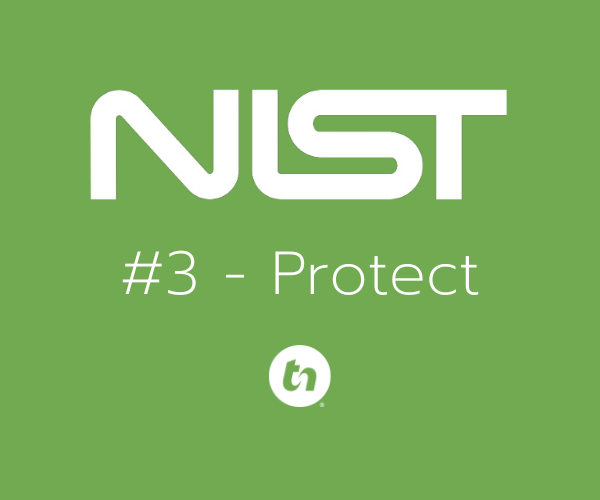In our ongoing series around the National Institute of Standards and Technology (NIST) Cybersecurity Framework (CSF), we cover the Protect pillar. Granted, I may have gotten ahead of myself in Part 2 given this comes BEFORE the Detect pillar, but detection and protection tend to go hand in hand.
What does the Protect pillar mean and how does it play a role in the overarching standards put forth under the NIST Cybersecurity Framework? Today we delve into the Protect pillar in greater detail around what it is and the proper way to implement this aspect of their framework.

Overview of the NIST Cybersecurity Framework Pillars
1. Identify: Develops an organizational understanding to manage cybersecurity risk to systems, people, assets, data, and capabilities.
2. Protect: Develops and implements appropriate safeguards to ensure the delivery of critical infrastructure services.
3. Detect: Develops and implements appropriate activities to identify the occurrence of a cybersecurity event.
4. Respond: Develops and implements appropriate activities to take action regarding a detected cybersecurity event.
5. Recover: Develops and implements appropriate activities to maintain plans for resilience and restore any capabilities or services impaired due to a cybersecurity event.
The Protect Pillar: In-Depth
The Protect pillar focuses on developing and implementing appropriate safeguards to ensure the continued delivery of critical infrastructure services. These safeguards support the ability to limit or contain the impact of a potential cybersecurity event. The Protect function is broken down into several key categories including:
1. Access Control:
- Identity Management and Authentication (Policy of Least Privilege): Ensuring that only authorized users have access to specific systems and information.
- Remote Access Management: Managing access controls to ensure secure remote access to organizational resources.
- Physical Access Controls: Implementing physical security measures to protect information systems and facilities.
2. Awareness and Training:
- Security Awareness Education: Providing cybersecurity training to employees to ensure they understand their role in protecting the organization.
- Role-Based Training: Offering specialized training based on employees’ roles to address specific cybersecurity responsibilities.
3. Data Security:
- Data-at-Rest and Data-in-Transit Protection: Implementing encryption and other measures to protect data stored on devices and during transmission. This is done via configurations and settings within your network and/or via a third party spam filter with encryption transmission capabilities.
- Integrity Checking Mechanisms: Using mechanisms to ensure data integrity and protect against unauthorized alterations.
4. Information Protection Processes and Procedures:
- Security Policies and Procedures: Developing and maintaining comprehensive security policies and procedures.
- Incident Response Plans: Establishing and maintaining incident response plans to ensure quick and effective response to cybersecurity events.
5. Maintenance:
- Regular Maintenance and Updates: Performing regular maintenance and timely security updates and patches on systems to ensure they remain secure.
- Controlled Maintenance: Ensuring maintenance activities are controlled and monitored to prevent security breaches.
6. Protective Technology:
- Network Segmentation: Implementing network segmentation to limit the impact of potential propagation of a cybersecurity event.
- Managed Detection and Response (MDR): Using Managed Detection and Response (MDR) solution – meaning it is backed by a 24/7 Security Operations Center (SOC) to protect endpoints from cyber threats.
What the Protect Pillar Means
The Protect pillar is crucial because it establishes the defenses that safeguard an organization’s operations and data. Here’s what it entails for an organization:
- Implementing Access Controls: Ensuring that access to systems and data is restricted to authorized users helps prevent unauthorized access and potential data breaches. This includes strong identity management and secure remote access protocols.
- Enhancing Security Awareness: Educating employees about cybersecurity threats and their role in mitigating these threats is essential. Role-based training ensures that individuals understand the specific risks associated with their roles and responsibilities.
- Securing Data: Protecting data at rest and in transit through encryption and other security measures ensures that sensitive information remains confidential and intact, even if intercepted.
- Developing Policies and Procedures: Establishing comprehensive security policies and incident response plans enables organizations to respond swiftly and effectively to cyber incidents, minimizing potential damage.
- Regular Maintenance and Updates: Keeping systems updated and performing regular maintenance helps prevent vulnerabilities that cyber attackers could exploit.
- Using Protective Technologies: Employing advanced technologies such as network segmentation and endpoint protection enhances an organization’s ability to defend against cyber threats and contain potential breaches.
The Protect pillar of the NIST Cybersecurity Framework is fundamental for establishing a strong defense against cybersecurity threats. By focusing on access control, security awareness, data security, protective technologies, and regular maintenance, organizations can significantly enhance their cybersecurity posture. Implementing these safeguards ensures the continued delivery of critical services and minimizes the impact of potential cyber incidents.

Chris Montgomery
ThrottleNet Sales Director
[email protected]



